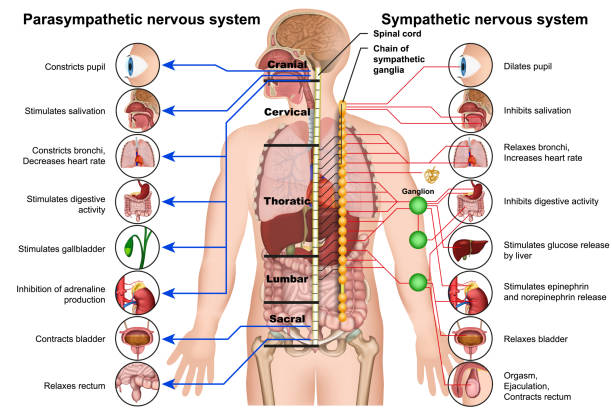When we speak about the importance of self-care, we think about how it might calm us down or how it teaches you to perhaps learn to know where your boundaries and tolerances lie. Or maybe you think about taking a bath, meditating and putting on a face-mask. One way or another, we are perhaps less aware of how self-care actually can work in your body, and what the effects of it can be on your Nervous System. In order to understand this, we will explore the workings of your Nervous System (in particular the Parasympathetic Nervous System) in this article in order to understand what self-care can be useful towards on a daily basis.
The Nervous System is where your bodily regulations and responses are being managed. There are three divisions in the Nervous System: Autonomic, Parasympathetic and Sympathetic.
Autonomic Nervous System is said to regulate the body’s unconscious actions. The Parasympathetic system stimulates and activates resting and digestion activities that occur when your body is in a resting mode, or at rest, especially after eating, sexual arousal, salivation, lacrimation (tears), urination and digestion. And the ways in which the Parasympathetic Nervous System operates is complimentary to the Sympathetic Nervous System which activates and stimulates your fight-or-flight response which we see when your body is experiencing stress, not to forget about chronic stress.
In other words, when your Parasympathetic Nervous System is activated or stimulated, you might experience feelings of calm and relaxation both in your mind and in your body. It is possible to learn to activate or trigger the Parasympathetic Nervous System to immediately reduce any feelings of anxiety and stress we might be experiencing. Trauma-Sensitive Yoga and self-care are some of the ways in which you are able to learn to activate and stimulate the Parasympathetic Nervous System and learn to regulate feelings of stress and anxiety.
There can be many causes of stress and anxiety in your life, this is all normal, it can be a new job or losing your job, maybe it is a relationship that is causing you anxiety or stress, or perhaps you struggle with trauma, depression and anxiety. For the Nervous System, it doesn’t matter. The fight-or-flight response was useful when you had to be careful not to cross paths with a lion or a tiger, nowadays everyday life events can activate and stimulate a response from the Sympathetic Nervous System without actual danger. The way in which the Sympathetic Nervous System causes your body to respond can be by a pounding heart, quickening of breathing, tensed muscles and sweating. This combined response to stress is what we call the fight-or-flight response.
Sweetwater Health has a beautiful way of describing the relationship between the Parasympathetic Nervous System and the Sympathetic Nervous System:
“The sympathetic and parasympathetic nervous systems act like the accelerator and brakes on a car. The sympathetic system is the accelerator, always ready to rev up and take us out of danger. The parasympathetic system is the brakes, slowing us down when danger isn’t present.”
But how does it actually work, when you encounter stress in our life? How does your Nervous System cope exactly? Even after the stressful event, the Sympathetic Nervous System still releases hormones that keep your body on high alert and ready for intense physical activity. Once the bodily threat is over, the Parasympathetic Nervous System will kick in and activate. The system slows down your response to stress by releasing hormones, such as cortisol, that relax mind and body while slowing down the high alert functioning of your body.
How do you learn to stimulate the Parasympathetic Nervous System to help reduce feelings of stress and anxiety? It could be by practicing the activation of the system, you are able to find a strengthened immune system and even a reduction in blood pressure. The following techniques, part of what we call self-care, can help you to activate and stimulate the Parasympathetic Nervous System during a stressful moment or on a daily basis to train the system to be active. These are often easier said than done.
– Spend time in nature
– Breathing techniques
– Learning to practice meditation
– Focussing on a calming word
– Cuddling animals or having fun playing with children
– Yoga
– Exercise
– Doing something you enjoy
Trauma-Sensitive Yoga can also be a way in which you learn to calm your body and your Parasympathetic Nervous System.
Many of these activities and tools, you might already be aware of, but it becomes harder and harder to practice them when you experience stress or anxiety in your life, it might even be something you experience constantly. During the practice of Trauma-Sensitive Yoga you spend time on developing stronger tools and reflection in order to be able to understand and know your own forms of self-care and what you might use to activate and stimulate your Parasympathetic Nervous System.
If you are interested in practicing Trauma-Sensitive Yoga, we are now accepting applications for the month of April.

Leave A Comment